|
|
 |
Digital Imaging
Capturing Digital Images
Paul R. Montague, CRA FOPS
Department of Ophthalmology and Visual Sciences
The Univesity of Iowa Hospitals and Clinics
Iowa City, Iowa
Digital Images from Video Cameras
One common means of image capture is through the use of a standard video camera. In the United States, video images are made up of 525 horizontal scan lines as defined by NTSC. A narrow beam is passed across the subject from left to right, constructing one scan line. That process is repeated until all 525 lines have been scanned. The final picture is acutally made up of two sets of interlaced pictures, but discussion of interlacing complicates the model and adds nothing to the basic concept.
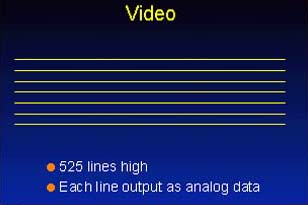
As the beam passes along one scan line, it produces voltage which varies with the brightness of the image. The beam produces higher voltage as it passes over bright objects, and lower voltage as it passes over darker ones. This electrical signal is called analog output, which can be used to produce a picture on a conventional television.
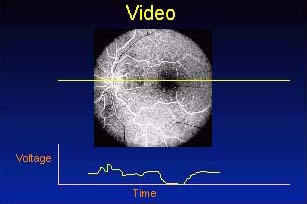
A computer component called an Analog to Digital Converter is used to change these voltages into numbers, creating a digital image. If a value of 0 is assigned to the lowest voltage produced representing the darkest area of the image, and a value of 255 is assigned to the highest voltage, then the numbers from 1 to 254 can be assigned to intermediate voltages representing shades of gray from black to white. This is a 256 level gray scale.
For the sake of simplicity, assume that it takes 1 second for the beam to scan one line (The time is actually much less). If the A/D board averaged the voltages produced for the first 1/10th second and assigned a gray value, then the next 1/10th second, continuing to the end of the line, that line would have been divided into ten separate numbers. A sample time of 1/20th second produces 20 values per line. A sample time of 1/100th second produces 100 values per line. The faster the sampling is done, the more horizontal resolution there is in the digitized image. The vertical resolution is fixed by the number of scan lines at 525.
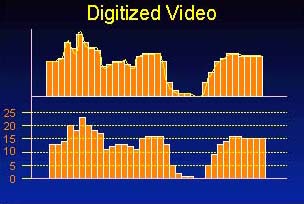
Digital Images from CCD Cameras
A Charge Coupled Device (CCD) works differently from a standard video camera. The CCD consists of a matrix of capacitors which can store an electrical charge sandwiched with a light sensitive photo cell. When an image is focused on this matrix, each square will produce a voltage relating to the average brightness of the light falling on the square. The output is analog, just as it was with the video camera, but the time slicing is not necessary. CCD cameras are often used on digital fundus cameras.
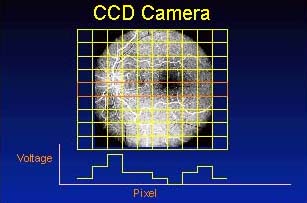
Another kind of CCD device uses only a row of light sensitive devices instead of a 2 dimensional matrix. In order to capture an entire image, the top of the subject is presented to the device and the first row is captured. The device is then moved down slightly, and the second row is captured. Then the third, and forth rows, and so on, until the entire subject has been scanned. This method is considerably slower than the CCD matrix, but the cost of the device is much lower. This type of CCD device is most often used in slide and flat-bed scanners.
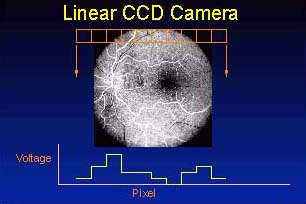
|
 |
|